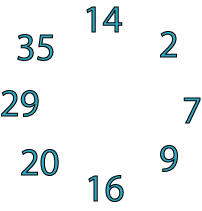Copyright © University of Cambridge. All rights reserved.
'Cycling Squares' printed from https://nrich.maths.org/
Show menu
Why do this problem?
This problem is a challenging one. It uses the learner's knowledge of square numbers and gives the opportunity of practising addition in an unusual context. It is a useful problem through which to discuss different methods of approach.Possible approach
You could start by reminding the group about square numbers, perhaps by playing a game of 'I like ...' where you write up numbers you 'like' (i.e. are part of a set) to one side of the board and numbers you 'don't like' (i.e. are not in your set) to the other, as children suggest numbers. The idea is for children to determine the name of your set.
You could then use the small cycle given at the beginning of the problem to introduce the idea of a cycle of squares, encouraging learners to check that each pair of numbers does indeed add to a square number.
(The cycle goes like this: 14 - 2 - 7 - 9 - 16 - 20 - 29 - 35 -.)
Then you could go on to introducing the actual problem. Learners could work on this in pairs, using numbered counters that can be moved round experimentally or number cards printed from this sheet.
At the end of the lesson, all learners could be involved in a discussion of how they tackled the problem, building up the cycle on the board, number by number. You could invite them to comment about the advantages/disadvantages of the different methods used and they may decide that one method is particularly efficient.
Key questions
Can you think of a good way to start?
Have you made a list of square numbers up to 100?
Which of the numbers given can be added to that one to make a square number?
If you cannot go on from there, what could you try instead?

